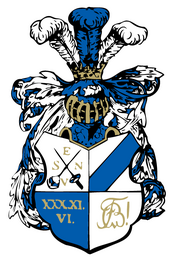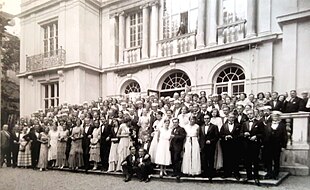Benutzer:Accelerator1955/Artikelvorbereitung

The Corps Bavaria of Munich is a German Student Corps located in the City of Munich. The Fraternity is a founding member of the umbrella organisation "Kösener Senioren Convent" and unites current students of all Universities in Munich and Amlumnus. As a German Corps it still practices the Mensur, the Members are wearing an academic ribbon as a sign of belonging. The fellows of the Corps are called "Bavarian from Munich", because in the early years only people from Bavaria were able to afffiliate.
Couleur
[Bearbeiten | Quelltext bearbeiten]Bavaria is known for their white-blue-white ribbon on golden ground. On special occasions the Bavarians also wear a white student Cap. New members (Füchse) have a ribbon with the colours white-blue on golden ground.[1][2]
History
[Bearbeiten | Quelltext bearbeiten]Landshut
[Bearbeiten | Quelltext bearbeiten]The Corps was founded on 30th November 1806 at the University of Landshut, which today is the Ludwig Maximilan University of Munich. Founding President was Joseph Count of Armansperg. He later became Bavarian Minister vor inner-, outer-, and financil affairs. As a minister for inner affairs he guaranteed the moving of the Corps from Landshut to Munich in 1827. In 1832 Armansperg became Archchancellor of the Kingdom of Grecce.[3][4]
Another founding member was Carl Joseph Anton Mittermaier, one of the best known Law Professors in the 19th Century. He was president of the Universities of Heidelberg and Landshut and later became President of the first democratic Parliament in Germany in 1848.[5][6]

Munich
[Bearbeiten | Quelltext bearbeiten]In July 1848 the President of the Corps Anton Baron of Lobkowitz was a Co-founder of the Umbrella Organistion, KSCV. Corps Bavaria became a full member in 1862 and still is today.[7]
During the 19th Century many Noblemen, Jurists and Medics were fellows of the Corps. As the Bavarian Corps in Munich many members served the royal family of Bavaria, the Wittelsbachers. Only two examples are Emil Knight of Schauß (he protected the royal treasure) and Theodor Imperal Earl Basselet of la Rosée (Educator of the Royal Princes Ludwig and Otto).[8]
In the Time of Natioal Socialism Corps Bavaria was forbidden as on of the first Corps, because they refused to work together with the National Socialistic Party. In 1935 they got forced to sell their own house, next to the University, to the Politican Adolf Wagner. One Alumnus, namely Eduard Brücklmaier, was executed due to his connections to the plot of the 20th July 1944.[9]
After the Second Worldwar the Corps was refounded on 13th July 1947, in 1963 the Alumnus bought a new house for the students in the district of Bogenhausen, this house was renovated and extended multiple times.[10][11] In honour of the 200th Anniversary a Commercium in the Hofbräukeller and a ball in the Hotel "Bayrischer Hof".[12]
Famous members
[Bearbeiten | Quelltext bearbeiten]Look up some famous members of the Corps Bavaria Munich here.
Sources
[Bearbeiten | Quelltext bearbeiten]- ↑ Corps. In: Studentenverbindung München | Willkommen beim Corps Bavaria. Abgerufen am 8. April 2020.
- ↑ Corps Bavaria München (@corpsbavaria) auf Instagram • 51 Fotos und Videos. In: www.instagram.com. Abgerufen am 8. April 2020.
- ↑ Joseph Ludwig Graf von Armansperg (Minister, Gutsbesitzer, Kgl. Kämmerer) - Biografien :: Haus der Bayerischen Geschichte. In: www.hdbg.eu. Abgerufen am 8. April 2020.
- ↑ Deutsche Biographie: Armansperg, Ludwig Graf von - Deutsche Biographie. In: www.deutsche-biographie.de. Abgerufen am 8. April 2020.
- ↑ Deutsche Biographie: Mittermaier, Karl Joseph Anton - Deutsche Biographie. In: www.deutsche-biographie.de. Abgerufen am 8. April 2020.
- ↑ UB Heidelberg: Carl Joseph Anton Mittermaier (1787–1867). In: www.ub.uni-heidelberg.de. Abgerufen am 8. April 2020.
- ↑ Kösener Seniorenconventsverband – MarkomannenWiki. In: www.markomannenwiki.de. Abgerufen am 8. April 2020.
- ↑ Vorlage:Citation
- ↑ Gedenkstätte Deutscher Widerstand - Biografie. In: www.gdw-berlin.de. Abgerufen am 8. April 2020.
- ↑ Süddeutsche Zeitung: "Woanders hätte es Aufstände gegeben". In: Süddeutsche.de. Abgerufen am 8. April 2020.
- ↑ Corpshaus. In: Studentenverbindung München | Willkommen beim Corps Bavaria. Abgerufen am 8. April 2020.
- ↑ Sebastian Sigler: Freundschaft und Toleranz. Academischer Verlag München, München 2006, ISBN 978-3-932965-86-9.